Monday 29th April
Arriving from Australia into Heathrow early on a Monday morning, my partner Alison and I recovered our luggage and made our way towards the immigration and customs areas. Though we should have been tired after a seven hour flight from Dubai preceded by an eleven hour flight from Australia, we were in fact elated and full of energy. We exited the Airbus A380, and made our way to the baggage collection area.
This was our annual sojourn overseas, and this year, we had planned a holiday which had us based primarily in the United Kingdom. A week of our vacation would be spent around the Normandy region of France, before returning to Scotland for a hire car drive to some of the more fascinating places there.
We had spent a few months researching, and after we had settled on the areas we wished to look at, Alison had devoted much time to sourcing our own accommodation.
We were surprised how easy it was to clear customs at Heathrow and soon made our way towards the hire car counter to collect our vehicle. As it turned out, collecting the car meant catching a courtesy bus from the terminal area to the facilities of the hire car company some kilometers away. The advantage of course was that we entered the traffic stream some time later, away from the hustle and bustle normally associated with a busy airport.
Our hire car was a small bright red zippy little vehicle which had only slightly more than one thousand kilometers on the odometer. Thus, to all intents and purposes, it was a brand new vehicle. Thanks to our GPS, we were able to exit the area reasonably easy, and within a short period of time, we were heading on our way towards Southhampton via the motorway. Traffic was heavy heading into London, but as we were going the other way, our side of the Motorway moved with reasonable ease. We were really happy that the weather was fine, with clear blue skies and a few wooly clouds dotting through.
Our journey swiftly took us toward the County of Hampshire, which had been recommended to me by a work colleague who had spent many years there prior to coming to Australia. Alison had planned to visit another town in the area called Kings Somborne, where her Great, great, great, great Grandfather had been born and christened. His mother was reputedly linked to the Royal family, and he was later sent as a member of the 66th Regiment to guard Napoleon Bonaparte on St Helena.
By now it was mid morning and we had made good time. We pulled off the motorway, and made our way into the small village of Crawley. This was to be our surprise package of the day. The village was wonderfully quaint with many houses sporting traditional thatched roofs. There was a pond with ducks swimming in it, and the whole scene epitomized what England was romantically envisaged to be. Daffodils and tulips coloured many gardens, and a local pub called The Fox and the Hound dominated the main street. It was a tranquil and idyllic setting, and we reveled in it. We walked around and soaked up the atmosphere of the village as if it were oxygen.
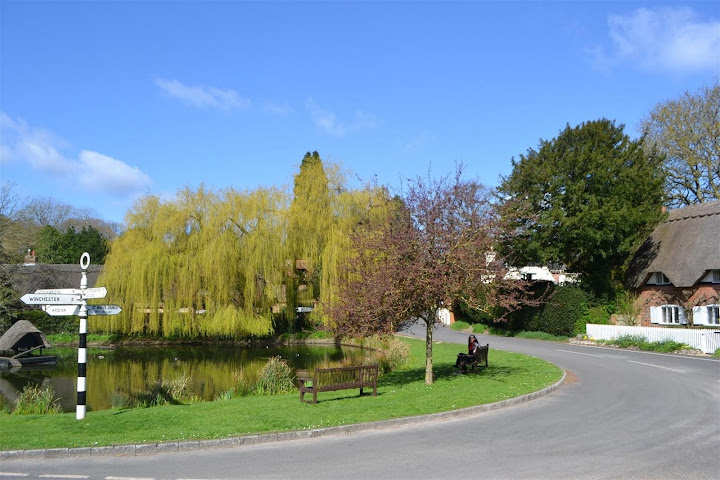
I had just finished taking a photo of Alison near the pond when an older man popped his head over the hedgerow of his own thatched cottage and asked if we would like a photo of the two of us together. He had been working in the garden of his thatch roofed cottage, and had noticed us taking pictures.
We started up a conversation with him, and learnt that he was the sixth generation of his family to occupy the cottage. I asked if I could take a photo of him with Alison in front of his cottage but he declined, saying he didn’t want to be photographed in his working clothes. He also casually mentioned that he was due to sit in court that afternoon. I pursued that comment, and he informed me that he was in fact a judge. He claimed to have known one of my favourite English judges, Lord Denning, and said he had lived nearby the town of Crawley. He was very entertaining and most sociable.
We concluded our conversation with us being quite accepting of his claim and we made our way back up the street to where we had parked our car. As we were retracing our footsteps up the narrow road, another friendly resident of the village greeted us and made conversation with us. He had been walking his dog, and when we mentioned the Judge we had spoken to, he did not seem to be aware of that fact and expressed surprise. Maybe we should not have been as accepting, for a search of the internet that night failed to turn up a link to the name of the Judge he had claimed to be. That of course was not terminal to his claim, but it raised doubts in my mind. It made for a good story in any event.
The small village of Crawley had been a wonderful introduction to our stay in Hampshire, and the bright sunny sky had made our experience picture postcard perfect. It was indeed hard to leave.
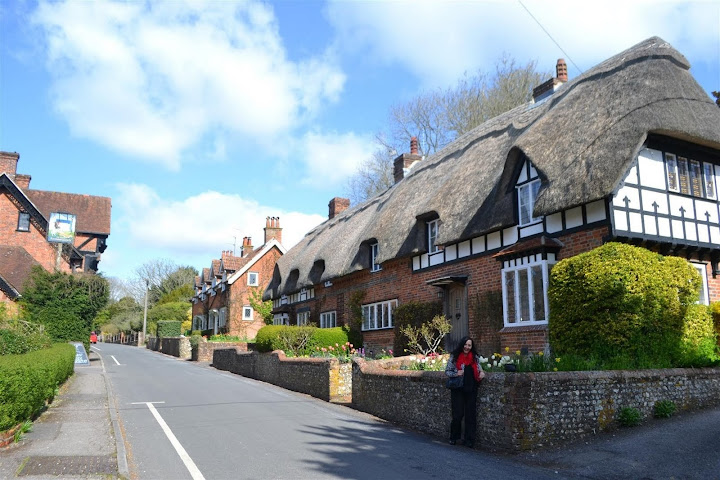
Leaving Crawley, we headed towards the nearby town of King's Somborne, which was of supreme interest to Alison. We spent some time there as she explored the church and looked for evidence of her ancestor. Kings Somborne was also a very quaint little village, and the Church with its old gravestones around the edge of the churchyard was typical of the type of Church often depicted in television shows and movies.
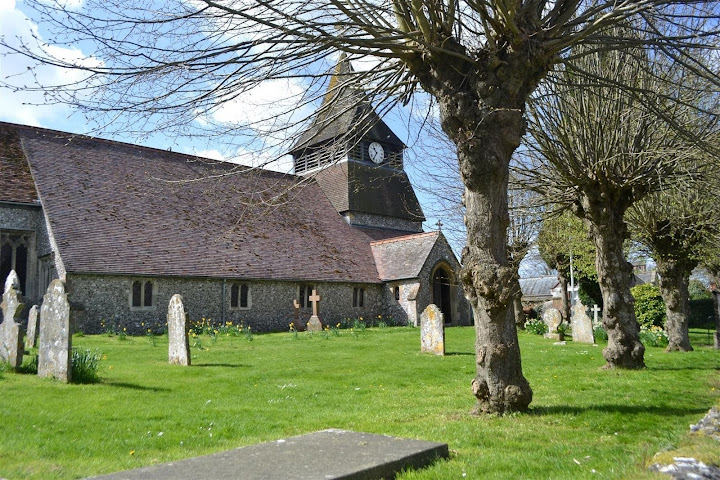
By now, the clear blue skies were being invaded by an ever-increasing collection of white puffy clouds, and conditions were in fact heading towards being overcast. We spent about half an hour in and around King's Somborne before heading in the direction of Winchester.
For me, Winchester conjured up the sounds of the New Vaudville Band with their 1960’s hit about Winchester Cathedral. We were to find out that the City of Winchester was indeed a bustling and busy town which was very much larger than envisaged. With the number of young people we saw as we drove around the streets, it was clearly a University town. I must confess that as appealing as the town was and as attractive as our sojourn through the streets was, we found it extremely busy with little prospects of finding a parking spot with ease. The one way street system that we had been caught up in meant that a fairly long traffic circuit was the result. In our tired and possibly jet-lagged state and with little sleep, our patience was wearing thin. After getting caught up in bumper to bumper traffic on our second drive through the town, we gave up trying to head for the precinct around the Cathedral, choosing instead to retreat towards a sanctuary of country spaces with little traffic to create stress and frustration. We thus decided to return a few days later when a good night’s sleep would have us refreshed.
Having left Winchester, we headed in the direction of a nearby town called Alresford, where we had read about the major attraction of a steam train called the Watercress Express. This had looked to be a magnificent picture of a bygone era with steam gushing from the locomotive as it made its way through lush green fields. Our tiredness dissipated at the thought.
As we made our way along the busy and winding road towards Alresford, we noticed a sign to another small town called Kings Worthy. Ironically, I remembered the town as the one my work colleague had informed me that he had lived in for some years. He had spoken at length about the “quaint pub” he had spent much time in and regaled us with stories of its quaintness. We thus decided that the steam train could wait and we would instead enjoy a nice lunch in the old inn in that small town.
The most prominent hotel in the small town of Kings Worthy was called the Cart and Horses and it dated back to the mid 1700’s. It was an eerie thought to know that the hotel had been built long before the first colonists had set out to settle in Botany Bay in 1788. It put the history of Australia in context with a small drinking establishment now on a moderately busy road, being older than the white settlement in New South Wales.
With the Cart and Horses oozing such a unique atmosphere, we decided to have a lunch in there and to experience the occasion. Clearly the décor had been updated since the 1700’s, and a modern and clean feel was evident. With the Australian Dollar enjoying solid benefits of a high exchange rate, we found the prices to be amazingly cheap with a luncheon main course costing less than five pounds. Converted to our currency, it was eminently reasonable. We enjoyed a coffee and a glass of red wine with our meal.
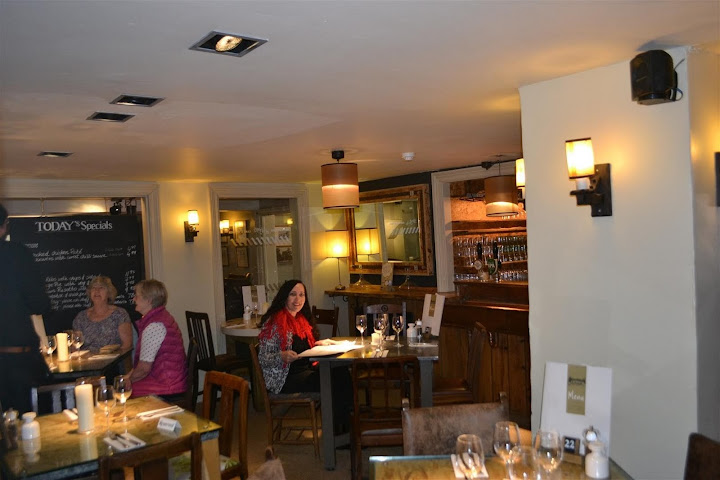
After a delightful lunch, we resumed our journey towards Arlesford and to hunt down the Watercress Express station. Unfortunately and to our dismay, the steam train we had come to see was not running - but there were many older style carriages on the rails which suggested it would be a popular destination on weekends. We had a quick look around the station precinct, but with our lack of sleep, we were both flagging a little and it was time to head towards the town of Fordingbridge to seek out our accommodation near that town. We were booked in the cottage we had sourced through the internet for a few nights and were looking forward to locating it. We thus rejoined the motorway and headed further south.
Fordingbridge is quite a large town on the edge of the New Forest. We had read about the ponies of the New Forest, but only minutes after passing through a type of gate which we called a “cattle gate” in Australia, we were to see the ponies for ourselves. The speed limit on the road was reduced to forty miles per hour, as numerous small ponies and horses grazed nonchalantly along the edge of the road. They were quite wooly in their appearance, and totally unafraid of human interest in them.
In late afternoon, we arrived in the cute town of Fordingbridge, which was quite large in comparison to most of the villages we had passed through this day. A fast flowing river that seemed to run through the town, and a picturesque bridge straddled the river. We learnt later that the location of the bridge and the fording nature of some form of bridge had existed since Roman times.
As our accommodation was self catering, we made our way to the local Cooperative supermarket, where we stocked up on supplies and then headed to look for our accommodation. We had little difficulty in locating it, as it was on the main Salisbury Road from Fordingbridge.
The Burgate farmhouse we had chosen to stay in dated back to 1485, and was topped by a thatched roof. The walls were extremely thick, and even though the entire farm fronted on to the Salisbury Road, traffic noise was almost non-existent. Our landlady Christine was there to greet us when we arrived, and showed us through the cottage with clear pride in the product she was making available to us. Like the Kings Worthy hotel, the age of the cottage was mind boggling and for someone coming from a country with a small period of history, hard to comprehend.
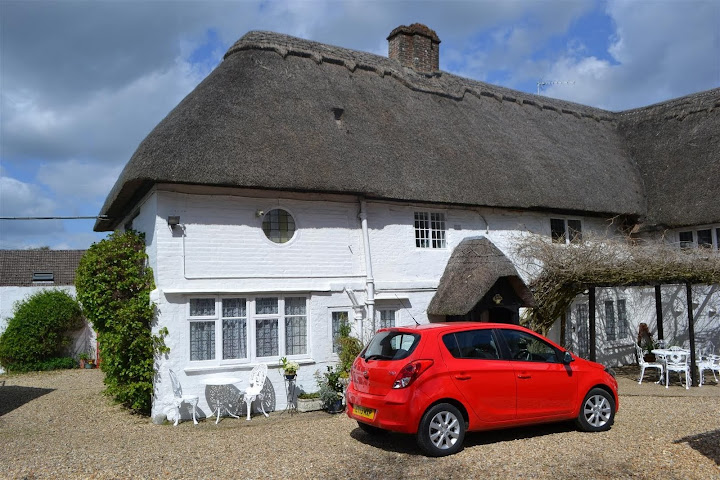
The doors and layout of the cottage were the strongest indicators of the age of our cottage, and it was evident that we were going to enjoy our stay. Christine had modernized the cottage so that all the comforts of home were there, but the historical connection beamed out through the entire cottage. We felt very elated to be staying there.
By now, it was getting late in the afternoon, and we were really slowing down. We thus decided to remain at the cottage and to spend the rest of the afternoon relaxing and recovering. By 5pm, we were enjoying our store-bought “homemade soup” and watching television. The temperature was plummeting and seemed well on the way to the predicted minimum of five degrees. We decided on an early night.
Look for continuing adventures from Wido!
